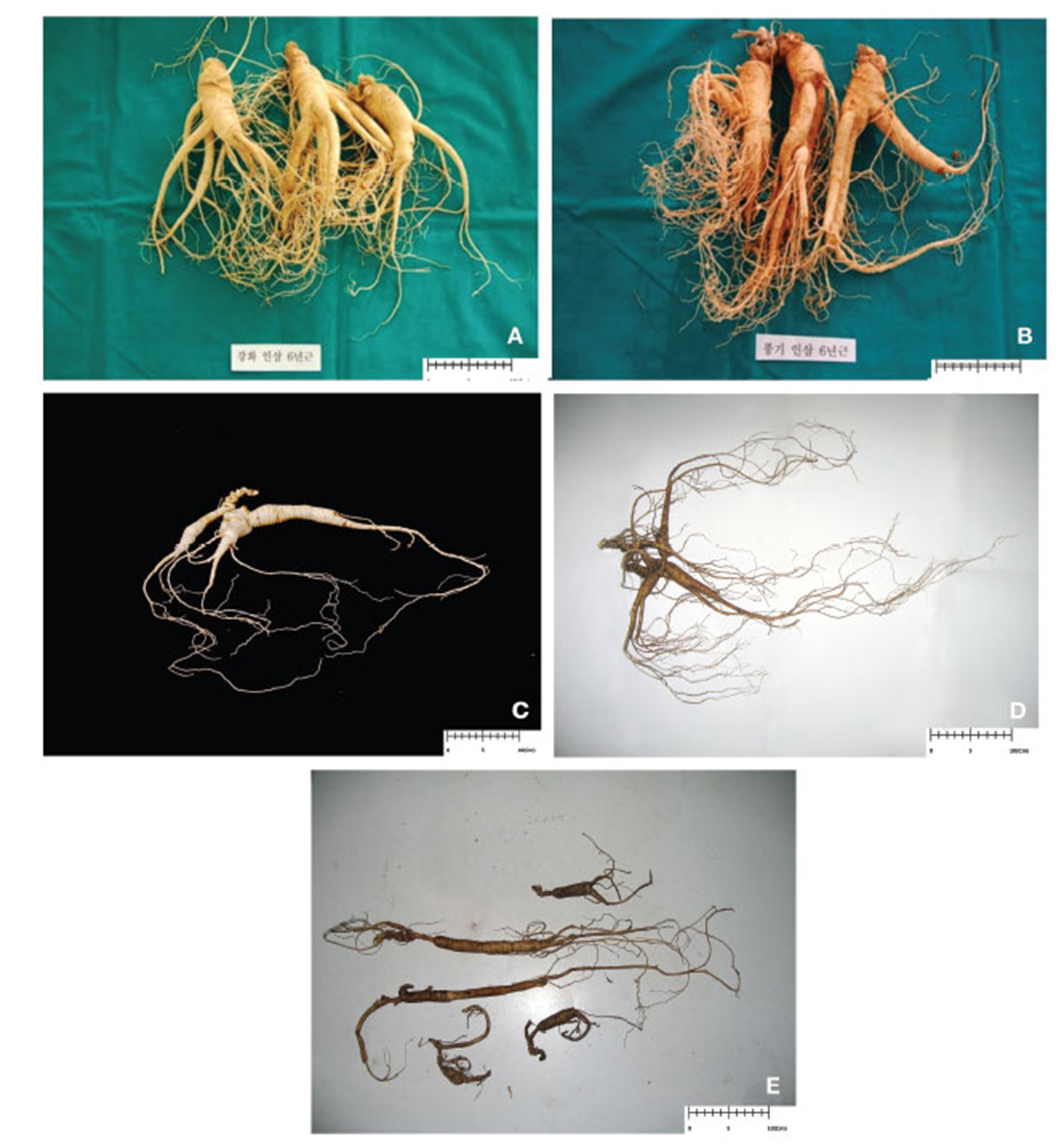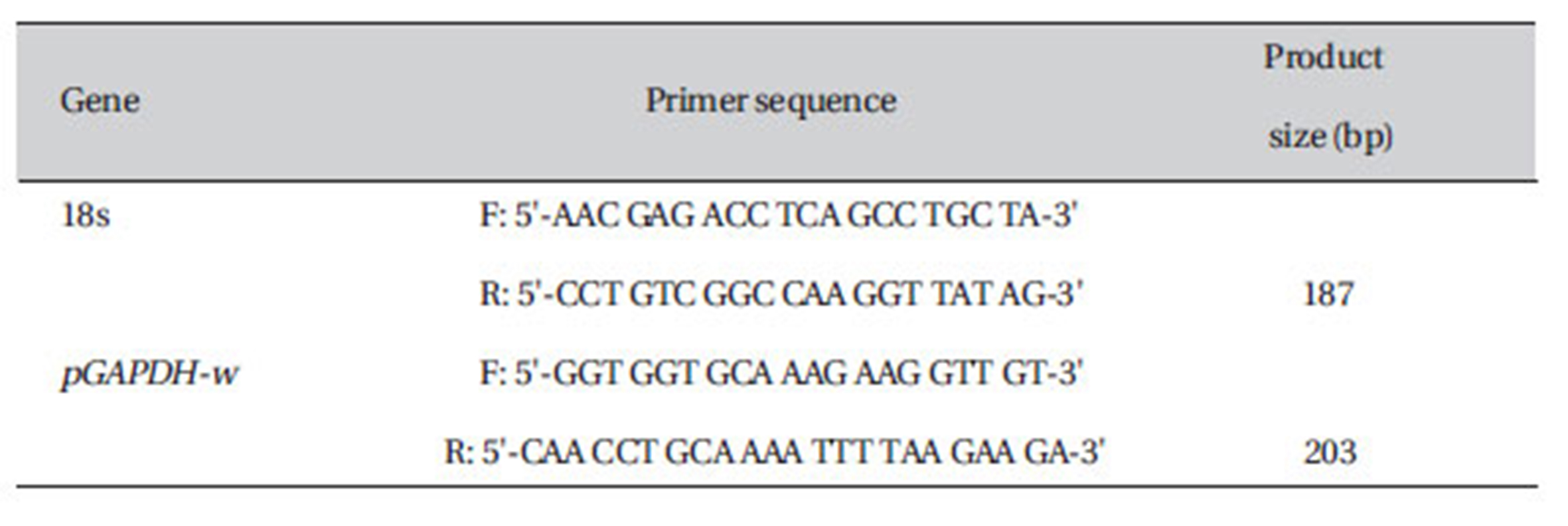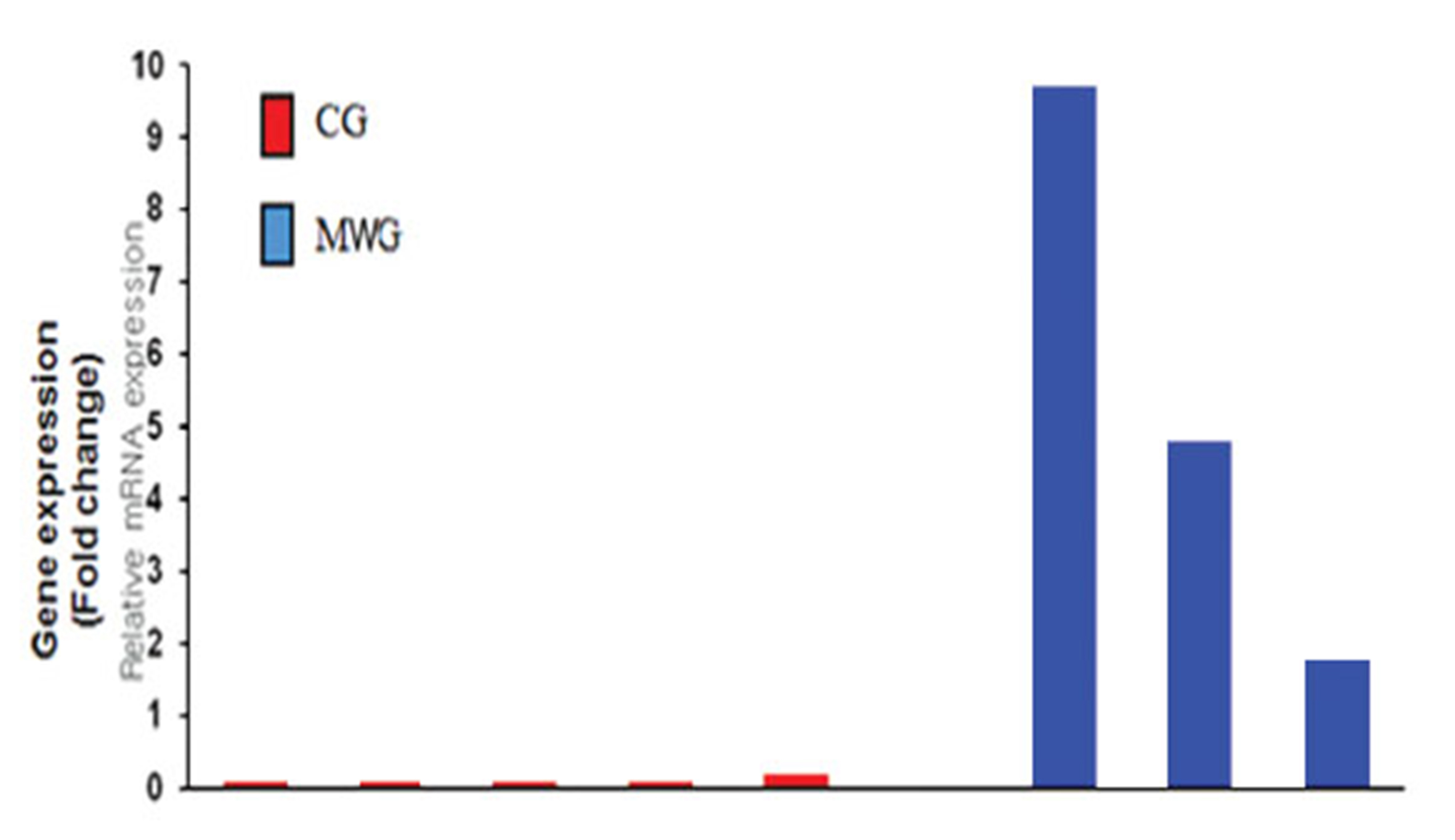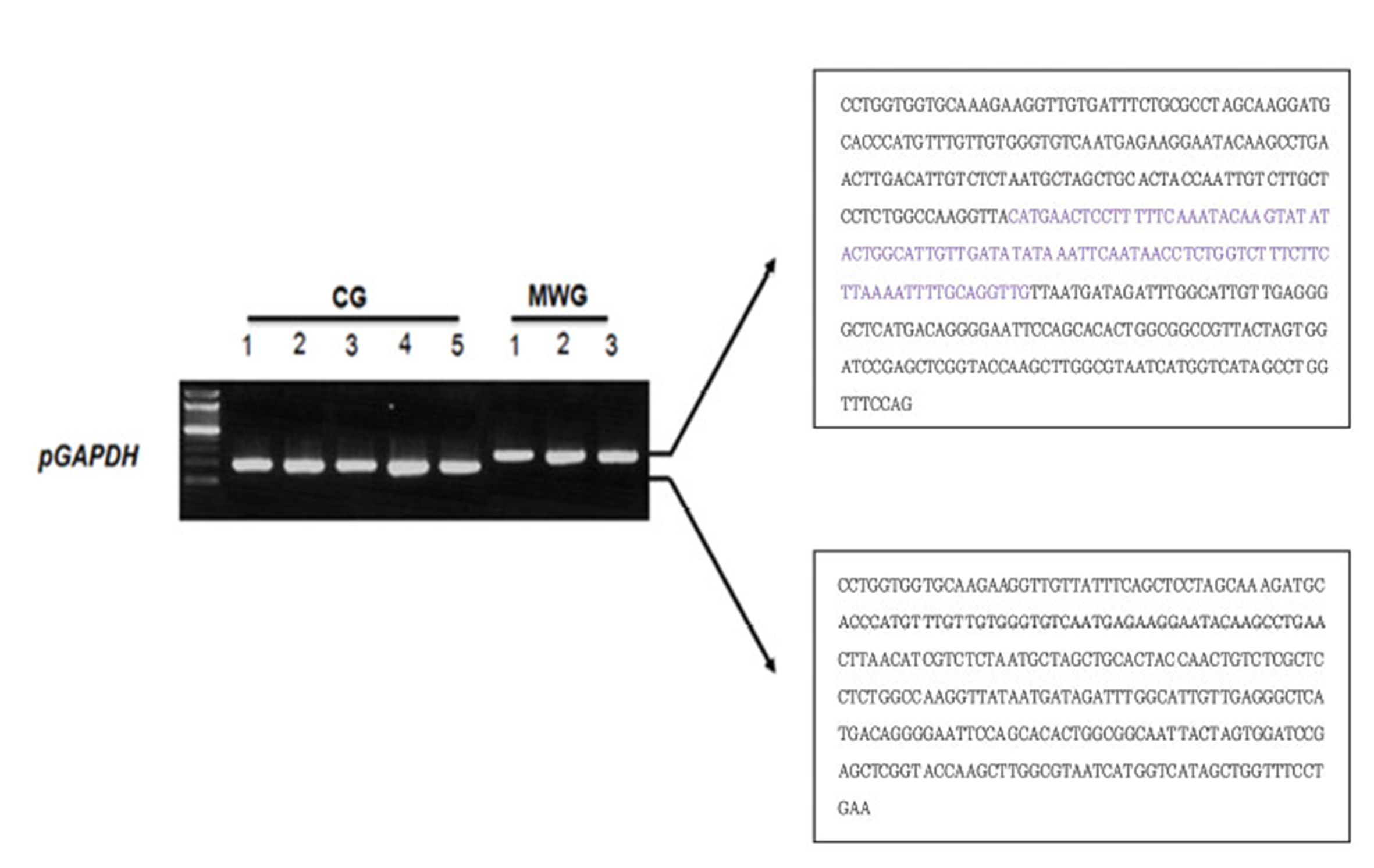



Panax ginseng is one of the most medicinally used herbal medicines in the world. Wild ginseng is widely accepted to be more active than cultivated ginseng in chemoprevention. However, little has actually been reported on the differences between wild ginseng and cultivated ginseng.
To identify wild ginseng-specific genes, we used suppressive subtraction hybridization.
We report that one of the clones isolated in this screen was the GAPDH (glyceraldehyde 3-phosphate dehydrogenase) gene (designated pGAPDH-w). DNA BLAST sequence analysis revealed that this pGAPDH-w gene contained novel sequences of 94 bp. RT-PCR results showed that the expression of the pGAPDH-w gene was significantly up-regulated in the wild ginseng as compared with the cultivated ginseng.
The pGAPDH-w gene may be one of the important markers of wild ginseng.
Ginseng,
In both Korea and China, wild ginseng (WG) widely accepted to be active than cultivated ginseng (CG) in chemoprevention. However, their high costs and rare distributions, few studies have reported on the difference between WG and CG. Also, lack of quality control has led to chaos in market distribution [5]. Thus, our research team conducted a study to identify WG specific genes for standardization, and we succeeded in identifying some WG novel clones, the
The SSH technique is believed to generate an equalized representation of differentially-expressed genes and to provide a high enrichment of differentially expressed mRNA. SSH overcomes the limitations of other gene analysis methods for differential expression. Its polymerase chain reaction (PCR)-based approach allows for the effective removal of common genes from the RNA population prior to creating the library and has the advantage of efficiently amplified reverse transcriptions [10]. In this study, we identified the differentiallyexpressed gene
2.1. Various Ginsengs for RNA isolation
The CGs used in this experiment were 4 and 6 yr of age from various regions in Korea. The WGs used in this experiment was collected from Changbai mountain. in 2008. They were about 20-40 cm long, weighed about 20- 30 g with the approximate ages of 30-50 yr (Fig. 1). The authenticit of the WGs were examined by a panel of the Korean medicine experts.
2.2 Total RNA isolation and mRNA purification
Ginseng was ground in liquid nitrogen by using a mortar and pestle, and RNA was isolated using an RNeasy Plant RNA Isolation kit (Qiagen). The concentration of the isolated RNA was estimated by measuring its absorbance at 260 nm. An aliquot of the RNA extract was treated with DNase-I (Invitrogen) prior to cDNA synthesis by using Superscript III reverse transcriptase (Invitrogen) and random hexamers according to the manufacturer's protocol.
2.3 Suppressive subtractive hybridization (SSH)
SSH was performed using a Clontech PCR-SelectTM cDNA subtraction kit (Clontech)according to the manufacture's protocol. The SSH method includes six steps (cDNA synthesis, RsaI digestion and adaptor ligation, two rounds of hybridization and PCR) for isolating differentially expressed genes. The cDNA fragments derived from the SSH forward subtractive library (tester: wild ginseng; driver: cultivated ginseng)were cloned into pEC-T vector (KOMA). The positive clones containing inserted fragments were identified by using the colony- PCR method.
2.4. Semi-quantitative real time-PCR
Semi-quantitative real time (RT)-PCR was performed to compare the differential expression of the genes in the SSH library by using gene specific primers. Total RNA (2 g) was used for cDNA synthesis with a First Strand cDNA Synthesis Kit (Invitrogen), and 1.0 ㎕ of cDNAs were used as a template for PCR. PCR amplification was performed under the following conditions: 95°C for 5 min, 30 cycles at 95°C for 45 s, 54°C for 30 s, and 72°C for 60 s. The final incubation was done at 72°C for 5 min. PCR products were electrophoresed in a 2% agarose gel.
2.5. Real-time quantitative-PCR
Real-time quantitative-PCR detection was performed with a StepOne machine and Fast SYBR Green Master Mix (Applied Biosystem, USA), and was measured in a 96-well plate by using a StepOne RT-PCR system (Applied Biosystems). For each well, the 20 ㎕ reaction involved 10 ㎕ of 2X Fast SYBR Green Master Mix, 0.5 ㎛ each for the forward and the reverse primers, 2.75 ㎕ of DNase-free H2O and 2 ㎕ of cDNA templates. PCR reactions were performed using the following parameters: 8 min at 95°C, and 40 cycles of 45 s at 95°C, 45 s at 56°C and 45 s at 72°C. PCR products were melted by gradually increasing the temperature from 60 to 95°C in 0.5°C steps. The identities of the amplicons and the specificity of the reaction were verified by using a melting curve analysis. Normalization of the cDNA templates was achieved by using an 18S quantification. The primers presented in Table 1 were used to analyze of
2.6. Sequencing and homology analysis
PCR products were cloned into the pEC-T vector (KOMA) and were then sequenced by the ABI 3700 DNA sequencers (Perkin Elmer Applied Biosystems). The sequence analysis was performed using Chromas sequence analysis software. BLAST was used for the study of similar nucleotide sequences.
3.1. Isolation of differentially-expressed genes in wild ginseng
To identify WG-specific genes, we subtracted WG cDNA from a pool of CG cDNA. The subtraction was expected to significantly reduce common cDNA and enrich for WGspecific cDNA. More than 100 transformants were obtained from the library, and the recombinant efficiency detected by colony-PCR was about 90%.
One hundred positive clones confirmed by PCR amplification were randomly selected, from which, 16 significantly different clones were sequenced. Because the SSH procedure includes a restricted enzyme digestion of the cDNA produced, none of the clones obtained from the resulting libraries were full length.

Primer for RT-PCR
Among the cDNAs identified here as putative wildginseng- specific gene is a putative homology of glyceraldehyde-3-phosphate dehydrogenases (
3.2 Quantitative RT-PCR analysis
To further verify that the
To confirm the differential expression of the
As shown in Fig. 5, all of the
Based on the growth environment and the cultivation method, commercially-trade ginseng is classified into three grades of ginseng, CG, mountain cultivated ginseng and WG. CG is cultivated artificially on farms and account for the majority of ginseng in the current market. MG grows in natural environments, vegetating in deep mountains, and mountain cultivated ginseng can be considered as a mimicry of WG which is seeded and growns up in forests and mountains. WG is considered superior to CG, and it has been shown to contain higher levels of ginsenosides, although Lui and Staba reported minimal differences in total ginsenoside content between WG and CG [11]. Compared to those of WG, the ginsenoside levels of CGs from more intensively cultivated garden locations were consistently lower, but the growth rate was consistently higher [12].
Most of the pharmacological actions of ginseng are attributed to a variety of ginsenosides, which are triterpenoid saponins [13,14]. The physiological and the medicinal effects of the various ginsenosides are different [15]. These differences may result in variations of the active compounds between CG and WG. In both Korea and China, WG is widely accepted to produce more potent medicinal activity than CG. However, few studies have been conducted to compare the components and the pharmacological activities between WG and CG.
In the present study, to identify the WG specific gene, we subtracted the cDNA expressed in WGs from that expressed in CG by using the suppression subtractive hybridization (SSH) technique, and we isolated a gene, the





